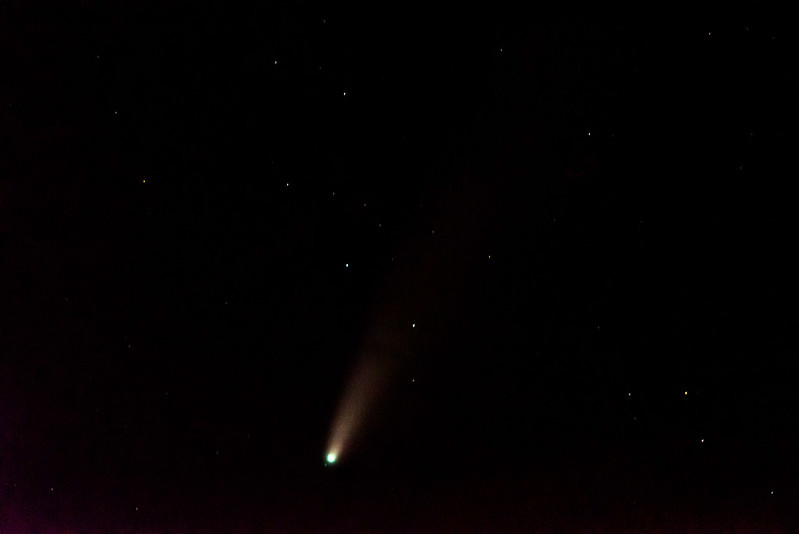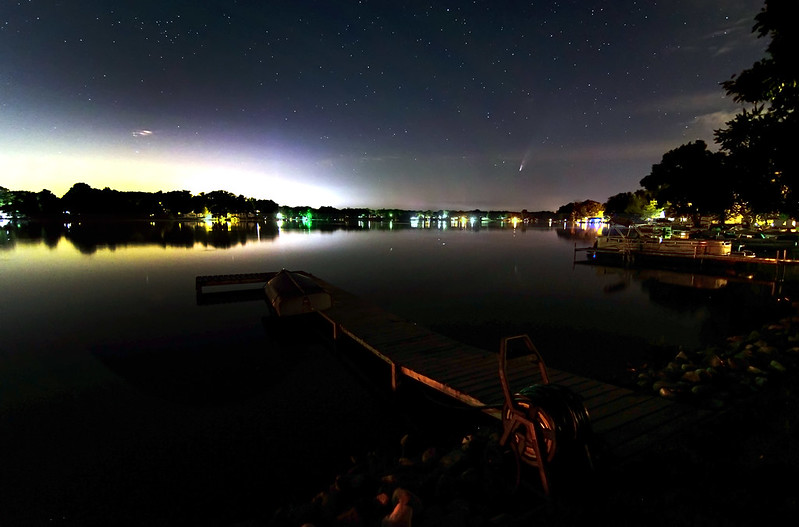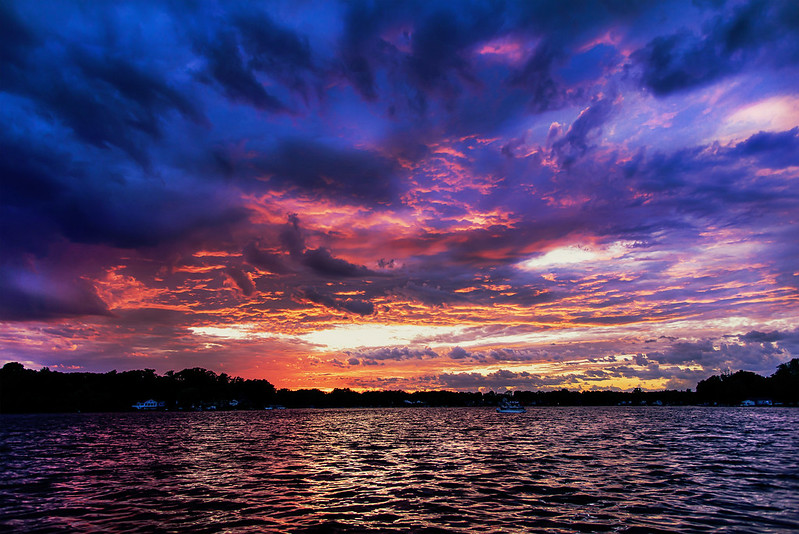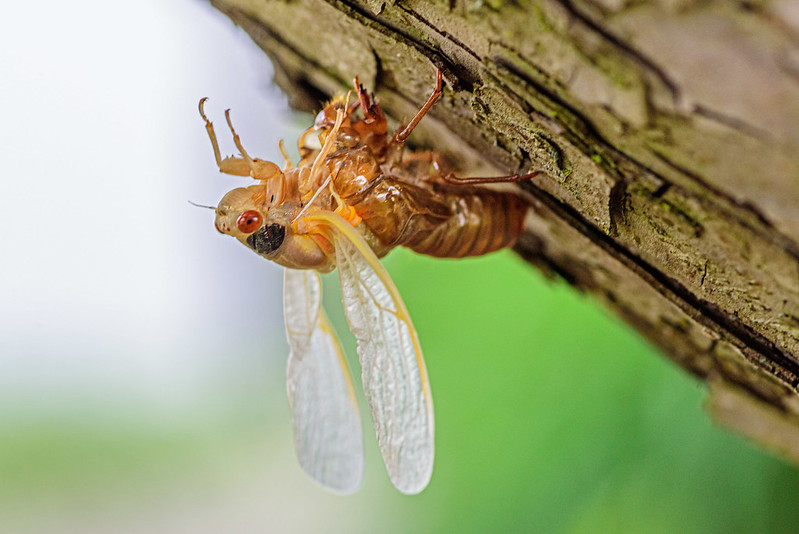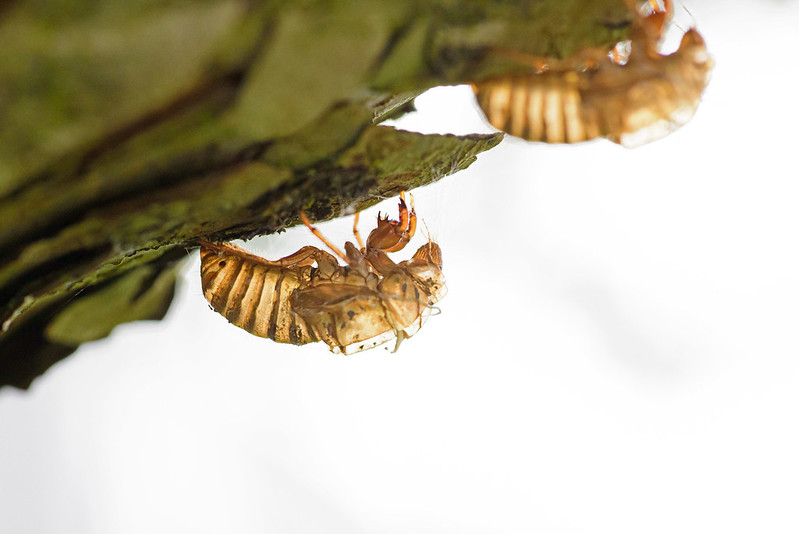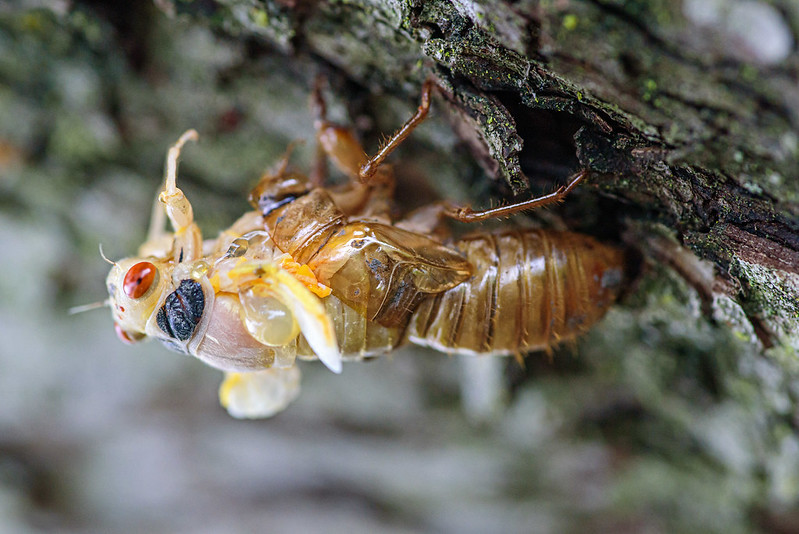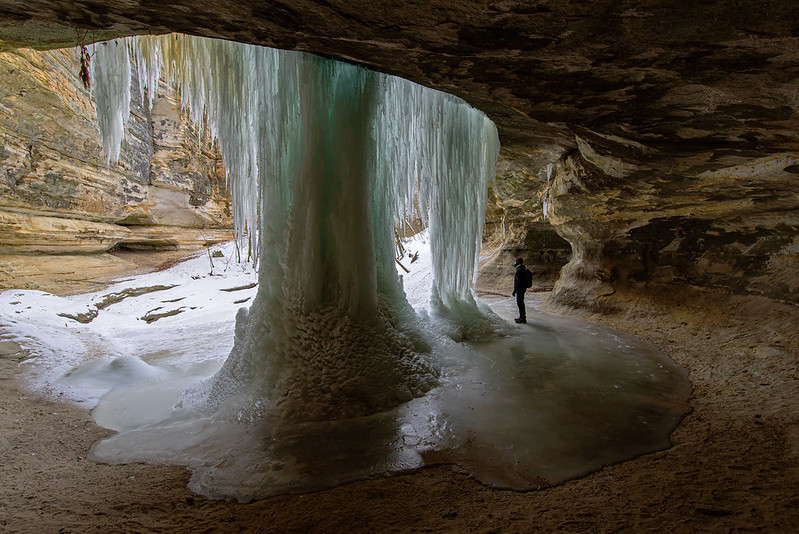





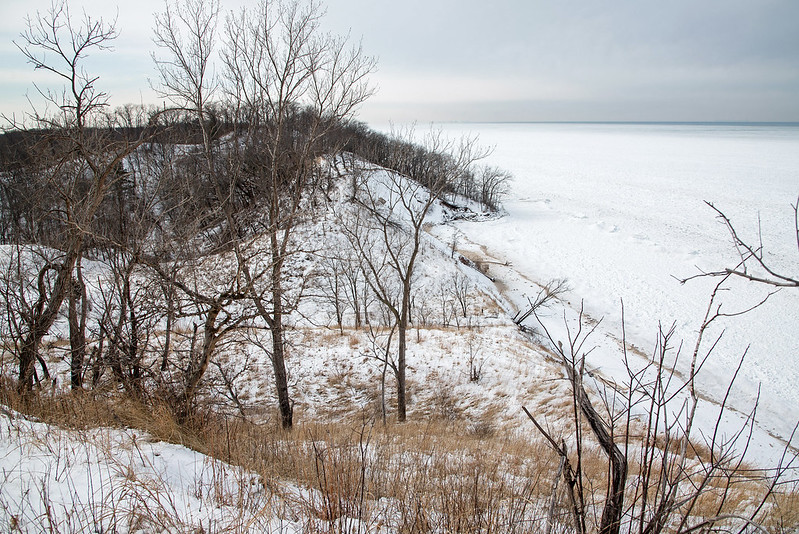

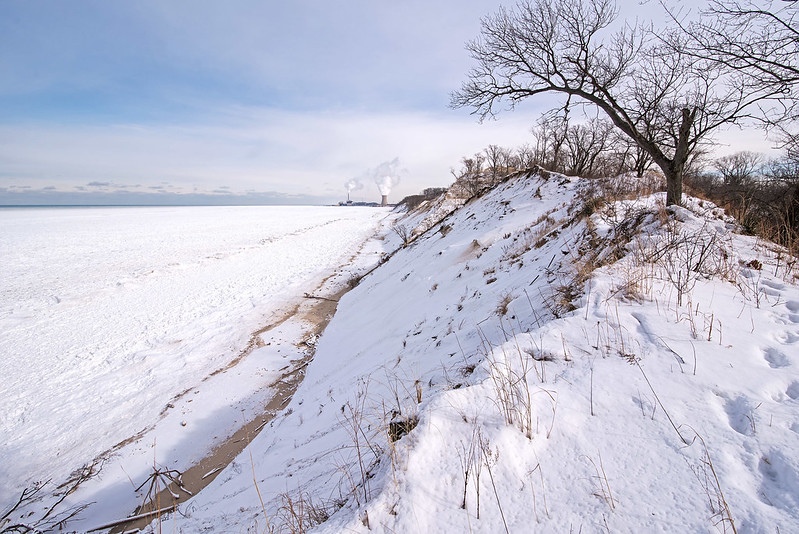
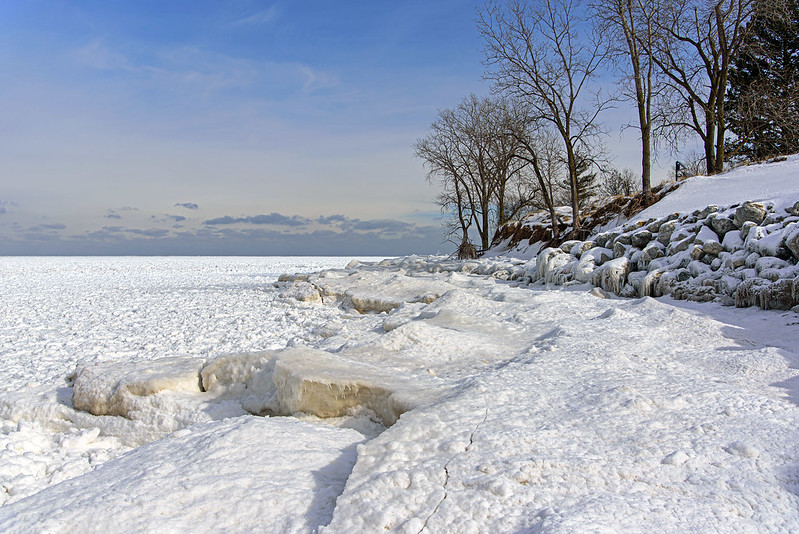




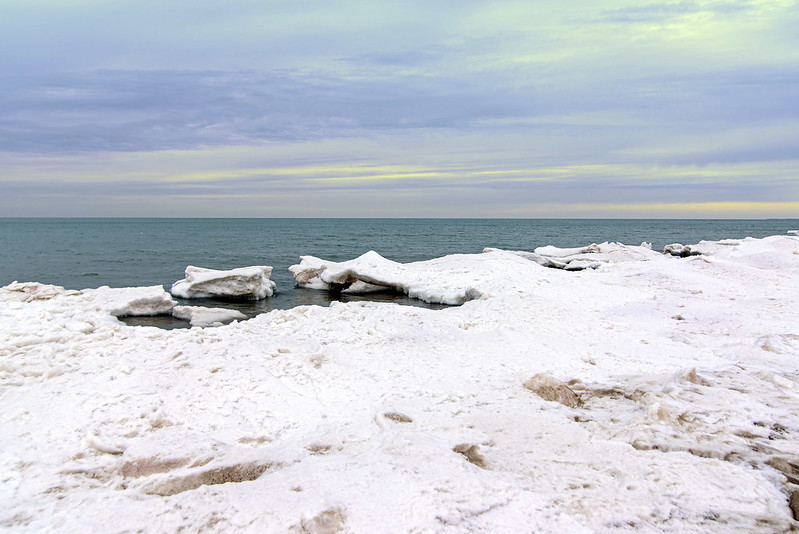


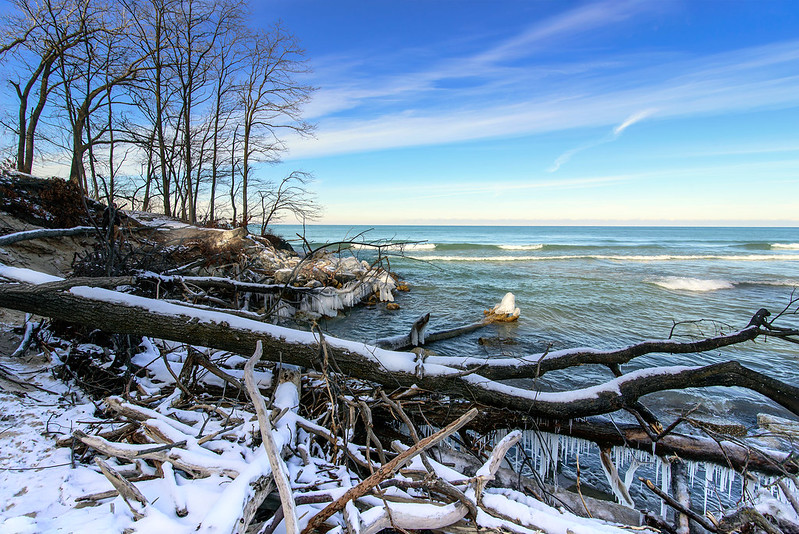


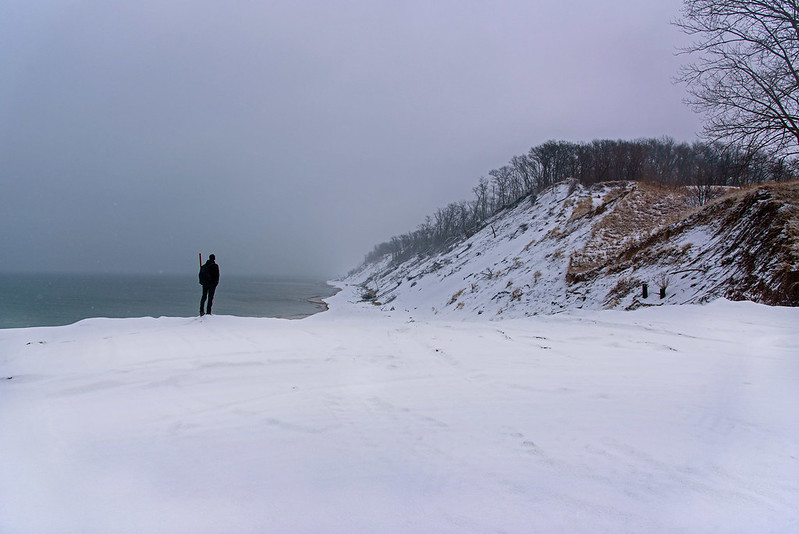 The Lake Michigan shore is fast eroding. If you think about it, it's a natural process - who says the beaches and dunes should never change? They would be wrong. The very reason the Indiana Dunes National Park exists is due to the natural processes of erosion and the winds depositing sand into piles along the shore. It's an ever-changing process, there is no "perfect state" where everything will become static and never change again. I think it's important for people to realize this - the beach and the dunes are changing, and that's okay. What needs to be stopped is change due to an unnatural cause. The pier in Michigan City was built to guide boats into Trail Creek. This pier has prevented sands from moving naturally along the shoreline past the creek. Therefore, the beaches to the west are "starving" sand is no longer naturally replentished so the dunes are collapsing at a fast rate. It's not erosion caused by someone walking on the dunes - contrary to what the Park Service wants you to believe. I know this because all of the dune ridge trails I used to walk along are long gone - part of the bottom of Lake Michigan. I didn't do that! The other visitors who have been packing down that sand for decades didn't do that! The waves did, and no amount of keeping people off the dunes would have ever prevented that. Our footprints are long gone.
The Lake Michigan shore is fast eroding. If you think about it, it's a natural process - who says the beaches and dunes should never change? They would be wrong. The very reason the Indiana Dunes National Park exists is due to the natural processes of erosion and the winds depositing sand into piles along the shore. It's an ever-changing process, there is no "perfect state" where everything will become static and never change again. I think it's important for people to realize this - the beach and the dunes are changing, and that's okay. What needs to be stopped is change due to an unnatural cause. The pier in Michigan City was built to guide boats into Trail Creek. This pier has prevented sands from moving naturally along the shoreline past the creek. Therefore, the beaches to the west are "starving" sand is no longer naturally replentished so the dunes are collapsing at a fast rate. It's not erosion caused by someone walking on the dunes - contrary to what the Park Service wants you to believe. I know this because all of the dune ridge trails I used to walk along are long gone - part of the bottom of Lake Michigan. I didn't do that! The other visitors who have been packing down that sand for decades didn't do that! The waves did, and no amount of keeping people off the dunes would have ever prevented that. Our footprints are long gone. 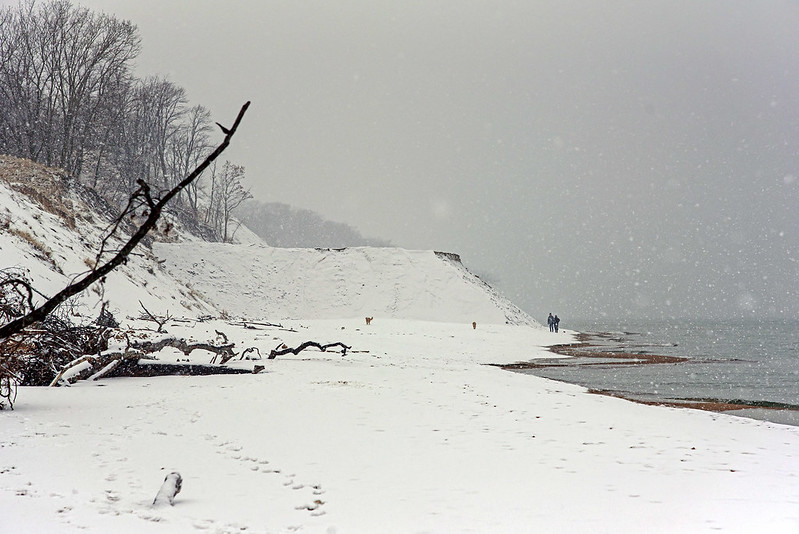 From time to time, the park has replentished the sand along these starving beaches to keep the waters from further eroding the dunes. They've piled boulders along the shore where there are roads or houses - to save property. The latest attempt at Central Beach is underway. From the beach we noticed a very tall pile of sand extending from the Central Beach access point. It's about 25 or 30 feet tall, and sticks out toward the water. My hope is this pile of sand is just the beginning, and they don't intend to leave it this way, because it looks terrible. My second hope is that this sand was collected locally, and not shipped in from somewhere far away, bringing with it stones and fossils from another area that don't belong here.
From time to time, the park has replentished the sand along these starving beaches to keep the waters from further eroding the dunes. They've piled boulders along the shore where there are roads or houses - to save property. The latest attempt at Central Beach is underway. From the beach we noticed a very tall pile of sand extending from the Central Beach access point. It's about 25 or 30 feet tall, and sticks out toward the water. My hope is this pile of sand is just the beginning, and they don't intend to leave it this way, because it looks terrible. My second hope is that this sand was collected locally, and not shipped in from somewhere far away, bringing with it stones and fossils from another area that don't belong here.  The view from this area is always quite beautiful, in any weather, even in the snowfall of this cold morning. Once Central Beach reopens, we should once again see the views from this dune.
The view from this area is always quite beautiful, in any weather, even in the snowfall of this cold morning. Once Central Beach reopens, we should once again see the views from this dune.
 Our morning hike began with a beautiful snowfall, as we made our way from Mt. Baldy along the shore to Kintzle Ditch. Narrow enough to jump across, we took running starts and jumped the 10 foot wide portion of the channel. Any wider and we would have landed in the water. We headed toward Central Beach exploring the wintery landscape safely, away from the lake, and the eroding dunes. Our return trip, we walked to the end of Central Beach, then up the small streets to Beverly Avenue, and hiked the road back to take in the views of the woods and wetlands. Some of the older streets still exist where homes once stood atop the dunes. Some local residents told us of a trail that is rarely used, but leads directly to the top of a tall dune near Kintzle Ditch, a stream winding through the dunes. As long as we stay on the trail and don't wander off, we wouldn't harm any of the plantlife or further erode the dunes.
Our morning hike began with a beautiful snowfall, as we made our way from Mt. Baldy along the shore to Kintzle Ditch. Narrow enough to jump across, we took running starts and jumped the 10 foot wide portion of the channel. Any wider and we would have landed in the water. We headed toward Central Beach exploring the wintery landscape safely, away from the lake, and the eroding dunes. Our return trip, we walked to the end of Central Beach, then up the small streets to Beverly Avenue, and hiked the road back to take in the views of the woods and wetlands. Some of the older streets still exist where homes once stood atop the dunes. Some local residents told us of a trail that is rarely used, but leads directly to the top of a tall dune near Kintzle Ditch, a stream winding through the dunes. As long as we stay on the trail and don't wander off, we wouldn't harm any of the plantlife or further erode the dunes.  As we approached the top of the dune, the wind suddenly increased to around 30 miles per hour (earlier on the beach there was barely a breeze). Snow could be seen over Lake Michigan, and it was advancing quickly. In a matter of moments, it was snowing at our location, and the winds were relentless. Not dressed for such conditions, we quickly headed back to the road, and made our way to the trail head. On our way back, the snow turned to rain, but at least on this side of the dunes, we were protected from the strong winds.
As we approached the top of the dune, the wind suddenly increased to around 30 miles per hour (earlier on the beach there was barely a breeze). Snow could be seen over Lake Michigan, and it was advancing quickly. In a matter of moments, it was snowing at our location, and the winds were relentless. Not dressed for such conditions, we quickly headed back to the road, and made our way to the trail head. On our way back, the snow turned to rain, but at least on this side of the dunes, we were protected from the strong winds.
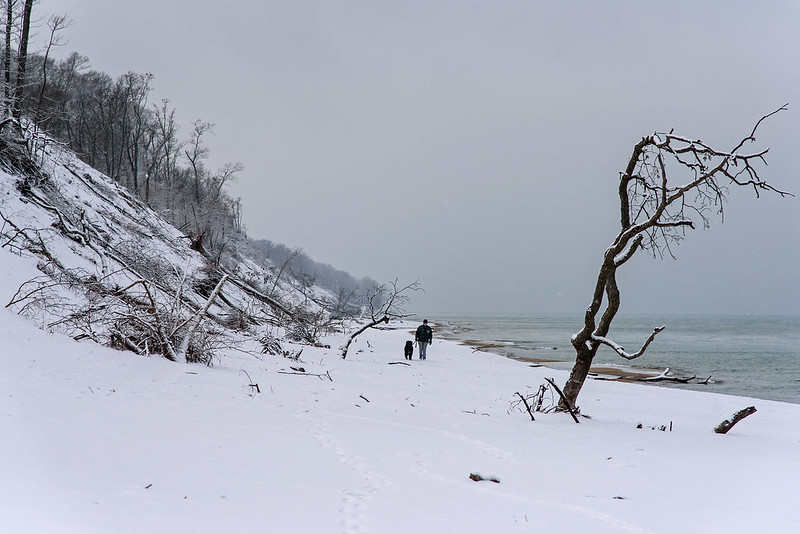
Some lake effect snow squalls created a postcard worthy lake shore on the Indiana side of Lake Michigan. What was all sand a week prior, was now dusted with snow and frost. The winds were almost nonexistent when we arrived, and periodically, snow would fall, sometimes heavy, but never accumulating very much.
Unusually, we encountered quite a few people on our hike, but not too many after we jumped over Kintzle Ditch, a stream running through the dunes to the lake. This weekend, at its narrowest point on the beach, it was about 10 feet wide, so we were able to jump across without getting wet. If we missed our mark, we would only end up in about a foot of cold water, not the end of the world. We just needed to make sure we didn't fall while jumping - landing on our backs in a foot of cold water would put an end to the hike, and make for a very cold half mile walk back to the car.
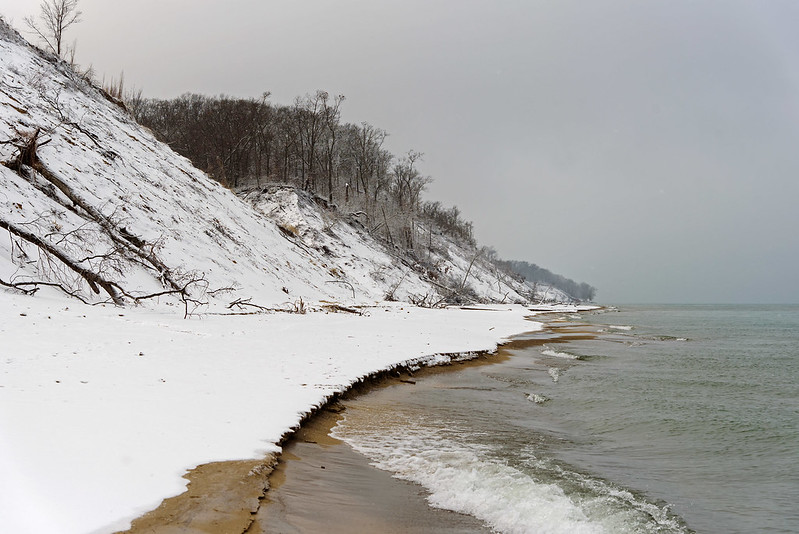 On our return trip, the snow turned to rain, and the winds picked up dramatically. Putting up with the wind-blown rain was one thing, but seeing the frost and snow disappear from the tree branches was the worst part. Now the shore was looking drab and brown once again, but probably not for long, as the forecast called for snow off and on all weekend.
On our return trip, the snow turned to rain, and the winds picked up dramatically. Putting up with the wind-blown rain was one thing, but seeing the frost and snow disappear from the tree branches was the worst part. Now the shore was looking drab and brown once again, but probably not for long, as the forecast called for snow off and on all weekend.
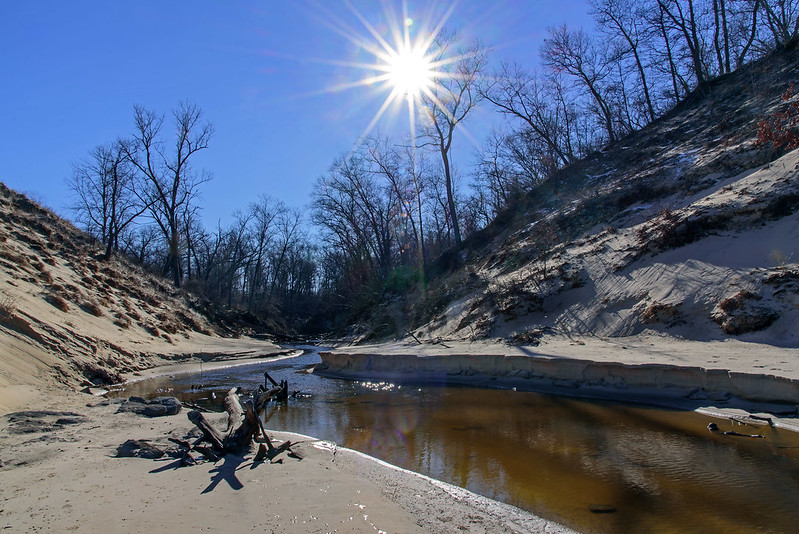 The sun was a welcome site after a long period of cloudy days, and it was just enough to warm us up as we hiked along the shore of Lake Michigan. With the sunshine, we didn't even notice the temperatures were in the upper 20's, we had to open our coats on the two mile hike. A midpoint of the hike was the ever-changing Kintzle Ditch, a small stream that cuts through the tall dunes and meanders into Lake Michigan. The constant wave action pushes the sand back and forth at the mouth of the creek, changing how it empties into the lake. Sometimes it's straight into the lake, other times it makes a sharp turn right or left and runs parallel to the shore for over a hundred feet. It's different every time I visit.
The sun was a welcome site after a long period of cloudy days, and it was just enough to warm us up as we hiked along the shore of Lake Michigan. With the sunshine, we didn't even notice the temperatures were in the upper 20's, we had to open our coats on the two mile hike. A midpoint of the hike was the ever-changing Kintzle Ditch, a small stream that cuts through the tall dunes and meanders into Lake Michigan. The constant wave action pushes the sand back and forth at the mouth of the creek, changing how it empties into the lake. Sometimes it's straight into the lake, other times it makes a sharp turn right or left and runs parallel to the shore for over a hundred feet. It's different every time I visit. 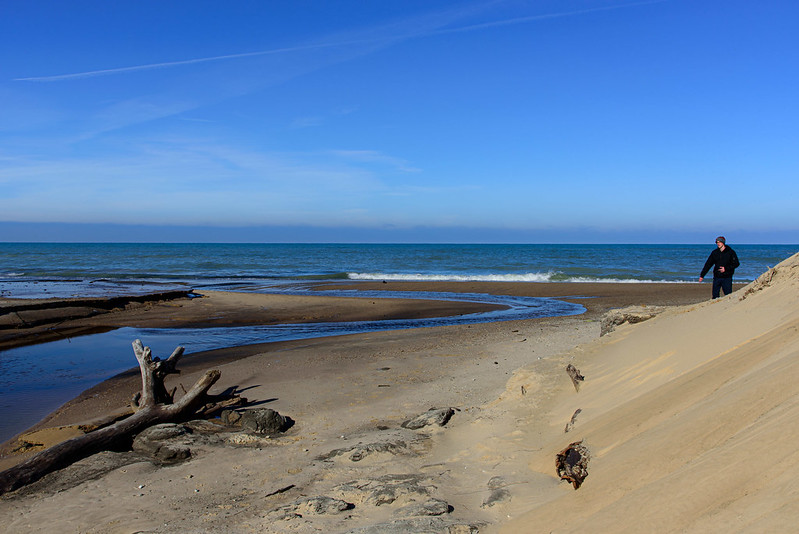 Colder temperatures are expected next week, so I expect some interesting winter scenes to play out here and all around the lakeshore. Of course I will be out there to experience it first hand.
Colder temperatures are expected next week, so I expect some interesting winter scenes to play out here and all around the lakeshore. Of course I will be out there to experience it first hand.
 Finally seeing the sun for the first time in days, maybe even weeks, we ventured to the Lake Michigan shore. Sunshine and beaches go hand in hand- right? Morning temperatures were in the mid twenties, but the sun and lack of wind made the trip very comfortable. Chicago was still under a ceiling of clouds, so this morning was even more special. As we approached the top of the dune, we could see the shadows of the trees down on the surface of Lake Michigan. If you look closely, you can see our shadows too, as we stand some 50 feet above the water. What you need to realize is that the trees laying in the foreground are full sized trees uprooted from the top of the dune. We are standing on the top of the dune, not on the beach.
Finally seeing the sun for the first time in days, maybe even weeks, we ventured to the Lake Michigan shore. Sunshine and beaches go hand in hand- right? Morning temperatures were in the mid twenties, but the sun and lack of wind made the trip very comfortable. Chicago was still under a ceiling of clouds, so this morning was even more special. As we approached the top of the dune, we could see the shadows of the trees down on the surface of Lake Michigan. If you look closely, you can see our shadows too, as we stand some 50 feet above the water. What you need to realize is that the trees laying in the foreground are full sized trees uprooted from the top of the dune. We are standing on the top of the dune, not on the beach.  Once down on the beach, we encountered a very interesting thing. The sand looks wet, but it's actually frozen. Not enough to see a glaze on the top, but enough to feel as hard as concrete and make it quite slippery in places. This is a time when you need to watch yourself (and especially children) as they walk along the beach. The water's edge is slanted toward the lake and this frozen sand can be so slippery, one can take a step and simply slide into the waves. I imagine the sand at the bottom of the lake is not frozen, so you would stop before getting too far into the water, but you would most certainly get pretty wet and very cold. It's a long walk to the parking area - especially when you're wet! Some ice formations are beginning to form along the shore, but nothing compared to the shelf ice that will most likely form in a few weeks.
Once down on the beach, we encountered a very interesting thing. The sand looks wet, but it's actually frozen. Not enough to see a glaze on the top, but enough to feel as hard as concrete and make it quite slippery in places. This is a time when you need to watch yourself (and especially children) as they walk along the beach. The water's edge is slanted toward the lake and this frozen sand can be so slippery, one can take a step and simply slide into the waves. I imagine the sand at the bottom of the lake is not frozen, so you would stop before getting too far into the water, but you would most certainly get pretty wet and very cold. It's a long walk to the parking area - especially when you're wet! Some ice formations are beginning to form along the shore, but nothing compared to the shelf ice that will most likely form in a few weeks.

We had no more than a dusting of snow for Christmas, but just after New Years, a bit of snow fell around us. The storm began with rain, then turned to snow, the perfect recipe for the snow to stick to each and every branch of the trees and shrubs, creating a winter wonderland of sorts.
At the Orland Grasslands - a 750 acre restored prairie in south suburban Chicago - there are more than 13 miles of paved and grass trails winding through the land. We encountered only two other people on this short trip. The prairie is an interesting place in all seasons, but there's something more exciting about this unforgiving land in the grips of winter. 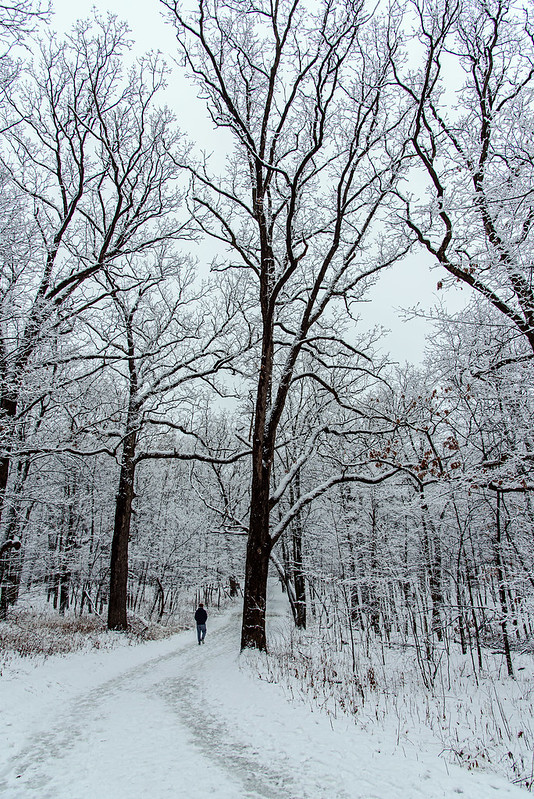
Unlike the grasslands, the trails at Swallow Cliffs were filled with families enjoying the snowfall. This is no small endeavor, because you must climb 125 limestone stairs to reach the top where the trails begin. People often use these stairs in the warmer months for exercise, but they're much more challenging in winter. The trails lie just to the south of the 100 foot bluff created by the glaciers and their meltwaters.
 The night sky was quite dark due to the tiny crescent moon that had set by 10:30 pm, so it was a perfect time to wander out in the night. On a lonely road, I set up my camera and tripod hoping to capture the Milky Way, and hoping I would not encounter any cars or headlights - those tend to ruin night images. Luckily, on this night, not a single vehicle came within sight, and I could see for miles around.
The night sky was quite dark due to the tiny crescent moon that had set by 10:30 pm, so it was a perfect time to wander out in the night. On a lonely road, I set up my camera and tripod hoping to capture the Milky Way, and hoping I would not encounter any cars or headlights - those tend to ruin night images. Luckily, on this night, not a single vehicle came within sight, and I could see for miles around.The lights of nearby Walkerton, some 6 miles away, can be seen illuminating the horizon, allowing us to see the trees along the horizon, and giving the sky some color.
The brighter spheres in the sky are Jupiter and Saturn, I believe, visible at night in the south sky.

